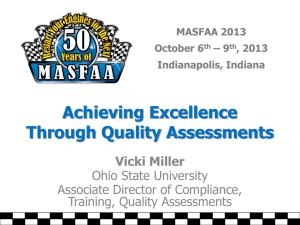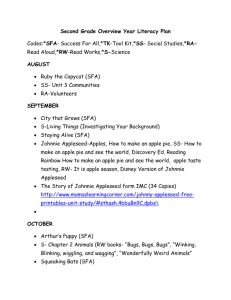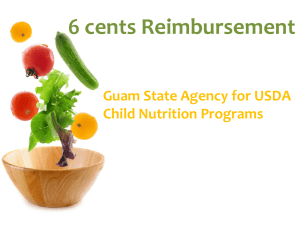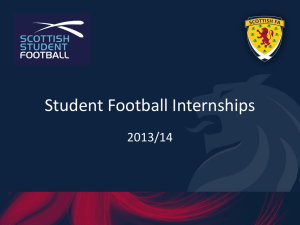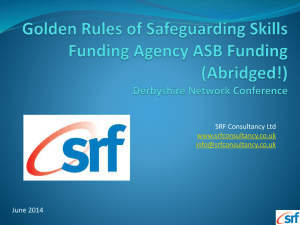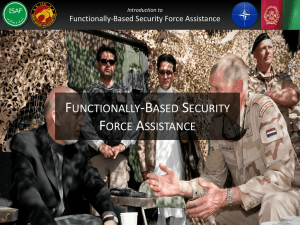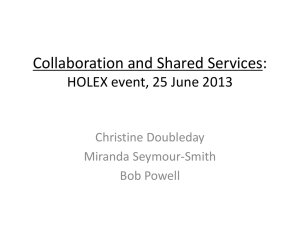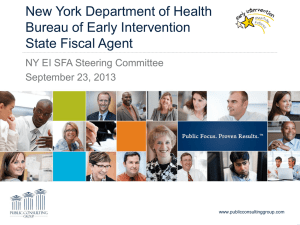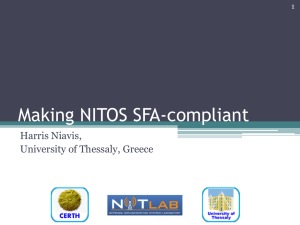Preparing for an Administrative Review
advertisement
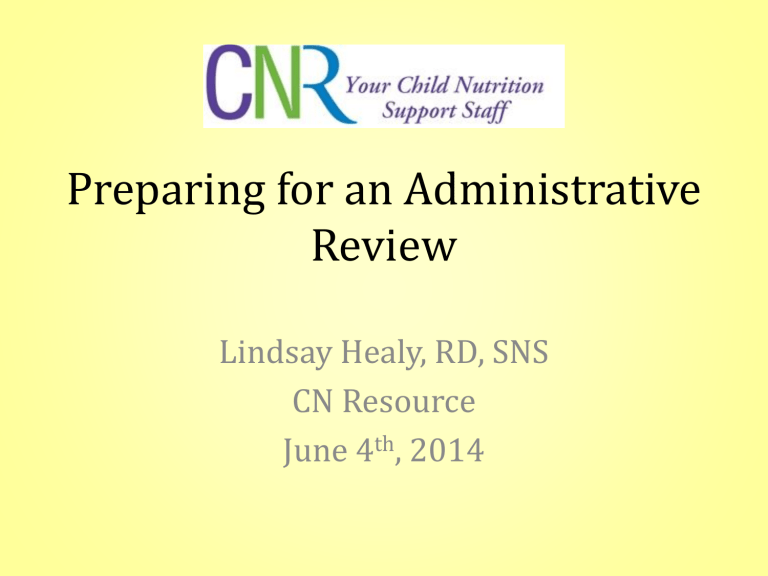
Preparing for an Administrative Review Lindsay Healy, RD, SNS CN Resource June 4th, 2014 What is the Administrative Review? The Administrative Review (AR) is the new USDA review process. This AR replaces both the old CRE and the SMI. The AR was introduced with the Healthy Hunger Free Kids Act of 2010. The 2013-2014 school year was the first year that it was implemented. Moving forward it is important to forget the ways of the CRE and SMI and embrace the changes! There are many similarities however, it is a different review and it is important to make sure everyone is aware and comfortable with the new review process. Step 1: Notification of Review The state agency will send a notification to all of the SFAs that are selected for review in SY 2014-2015. They will receive a letter letting them know that they will be contacted to schedule the review. Step 2: Scheduling the Review Determining the site(s) for review: • The number of sites selected for review is based on the number of participating schools within the SFA. • There are USDA criteria that is used when selecting the specific sites. • The length of the on-site review will be based on the number of sites that must be reviewed and the number of meal applications that will need to be reviewed. Step 3: Pre-Review Procedures Selecting the site for a targeted menu review: • Meal compliance assessment procedures Additional Pre-review documents: • Off-Site Assessment • Dietary Specification Assessment Tool (targeted menu site only) • Menu Documentation Review Off-Site Assessment When completing the Off-Site Assessment: • Work as a team • Answer the questions completely • Be as accurate as possible • Call and ask if there is a question you don’t understand • Submit it by the due date • Submit all the requested supporting documents Dietary Specification Assessment • Only needed for the site that is selected for the Targeted Menu Review. (the reviewer will let you know what site this is) • The reviewer will tell you if you need to complete breakfast and lunch or lunch only. • Read each statement carefully. • Answer each statement honestly. Menu Documentation Review Week of Menu Review A single week from the review month will be selected for the menu documentation review. The reviewer will work with the SFA to determine the week. What Menus are Reviewed? All unique menus that will be observed at the review site(s) must be submitted for menu review. What Menu Documentation Needs to be Submitted? Production Records, Menus, Standardized Recipes, Labels, CN labels Step 4: On-site Review SFA Level: • Applications • Verification • Claims • Resource Management* • Civil Rights • Wellness Policy • Food Safety Plan • Record Keeping • SBP and SFSP outreach • FSMC* Site Level: • Point of service • Meal components • OVS • Kitchen walk through • Civil rights • On-site monitoring • Competitive Foods • Water • Food safety • Record Keeping Certification and Benefit Issuance Eligibility Benefit Issuance list from Eligible allDocumentation sites Students participating within the SFA Categorically MUST: Students Extended IncomeFoster Eligibility Applications Students through MUST MUST: theinclude: Direct Certification ••Supplemental Total number of eligible students in the SFA Nutrition Assistance Report Program (SNAP) orreviewed. Temporary Reviewer will determine whichMUST: applications will be •• Assistance Identify students were selected for Verification Names ofwhich all forhousehold Families (TANF) members or Food Distribution Program Be on an approved complete list (Homeless, Migrant, Applications will beand reviewed district wide, not just selected on Have Indian an approved Reservations application (FDPIR) file OR MUST include: Head sites. • Runaway, List must come Start) from the point on ofApplications service All household documented the Direct income Certification and frequency Report or on a •• Be A of on denied applications will also be reviewed. Nopercentage duplicatesmember’s Case separate Have approved from the County indicating their Be onNumber thedocument. Directdocumentation Certification Report • List of students eligible for free and reduced meals (do not Indication status of no income for those that have none SFAfoster must provide: include paid students). For each student listwere mustadded, provide: Signature The documentation of adult household must include member the datethe they and • Certification Document (application, direct certification, • student’s name, Signature the eligibility student of that adult household reside with member that is listed on the Direct list)they • schoolReport. name, Certification • Verification documents (if applicable) Last 4• digits ofstatus, Social Security Number benefit • Notification of benefits • method of certification, • Any follow-up and/or with *Must be approveddocumentation using the correct USDAcommunications Income Eligibility • date of certification the household Guidelines Verification All Verified applications will be reviewed • • • • Initial application Notifications sent to households Verification documents submitted by households Notification of results of Verification • Reviewer will complete a detailed review of 10% of verified applications • Summary of Verification Efforts • This is the report that the SFA is required to maintain each year, but is NOT required to submit to the State. Claim for Reimbursement and POS Claiming documents from all sites within the SFA will be reviewed • Review month claim from each site • Edit check from review month for each site • Consolidated claim for review month Point of Service (POS) Does the system avoid overt identification? Does it provide an accurate meal count? How are meals consolidated at the end of service? How does the POS ensure that students are not claimed more than once? Meal Compliance Resource Management Audits Non-Profit School Food Service Account Paid Lunch Equity Revenue from Non-Program Foods Indirect Costs USDA Foods Paid Lunch Equity Tool http://www.fns.usda.gov/paid-lunch-equity-school-year-20142015-calculations-and-tool Non-Program Foods Revenue Tool http://www.fns.usda.gov/cnd/governance/policy2006-2011.htm Civil Rights • The SFA's public release • Description of the SFA's procedures for receiving and handling a Civil Rights complaint • Information on the number and description of complaints alleging discrimination in the current and prior school year • Date, agenda and attendees of the recent Civil Rights training for the SFA staff • Need and availability of translation services • Description of the SFA's procedures for collecting racial/ethnic data • The non-discrimination statement used on all program materials • "And Justice For All" poster On-Site Monitoring *Important: On-site monitoring is only required if the SFA has more than 1 building that participates in the NSLP and/or SBP. Documents to Review: Current year on-site review forms http://www.fns.usda.gov/cnd/governance/PolicyMemos/2011/SP14-2011_os.pdf Wellness Policy At a minimum the Wellness Policy must include: 1. Goals for Nutrition Education 2. Goals for Physical Activity 3. Goals for other school based activities to promote wellness 4. Nutritional guidelines for all food sold on campus 5. Goals for Nutrition Promotion *The wellness policy should be developed by a team that includes, teachers, food service staff, parents, administration and students NEW with Reauthorization: 1. SFAs are required to make the Wellness Policy public 2. SFAs must periodically measure the implementation of the policy 3. The SFA must designate one or more school officials to ensure compliance with the wellness policy Competitive Foods & A la Carte 1. Ensure that there is no sale of competitive foods and that foods of minimal nutritional value are not available during meal service in the serving or dining area. 2. All food sales must be incompliance with the new guidance for the 2014-2015 school year. 3. Have copies of the nutrition labels of all foods sold within the school during the school day available for review. Water The Healthy Hunger Free Kids Act requires that potable water be made available to all program participants free of charge during both breakfast and lunch service. While observing breakfast and lunch you must ensure that free water is available for consumption by program participants. Schools can provide water in a variety of ways: • Water pitchers and cups on tables • A water fountain • Water dispenser with cups in the cafeteria Food Safety Food Safety Inspections •Copy of the most recent food safety inspection must be posted at each site in a prominent location • The SFA needs to provide documentation of the two most recent inspections Temperature Logs •For the cooler(s), Freezer(s) and Store room •For all food that required cooking to an established internal temperature •For food that needs to be maintained below 41 Food Safety Plan Copy should have already been submitted with off-site assessment, but each site should have a copy maintained on site. Record Keeping As you review other areas, you should be evaluating that the appropriate reporting and record keeping requirements are in compliance. Page 166-167 of the Administrative Review manual list the common reports and records that the SFA must have on file. Other Programs Afterschool Snack Program (ASSP): Ensure that production records are maintained and all snack items offered are creditable. Fresh Fruit and Vegetable Program (FFVP): Have documentation of products served and detailed claims for reimbursement. Special Milk Program (SMP): Pricing Policy, counting and claiming procedures, milk service procedures and records. Seamless Summer Option (SSO): Meal counting and claiming practices, menu planning, and meal service. Step 5: Administrative Review Report The reviewer must provide the SFA with written notification of the review findings: • Superintendent or authorized representative • Commendations • Review findings • Corrective Action Plan • Potential for Fiscal Action • Right to an appeal How can I have a Great Review? Team work: Get everyone involved Provide in house trainings Don’t leave it up to just one person Organization: Determine the best way to present all the requested materials Binders, folders, paperclips, hanging files, etc. Over prepare!! Double, triple check everything Read all of the guidance and resources that are available This seems overwhelming… • Start early • Ask questions • Submit requested information by requested dates • Be responsive • Use your team to get prepared • Don’t wait until the morning of the review • Stay up-to-date on trainings Use the Review tools • All of the administrative Review forms are on the USDA website • Do an in house review using the tools • Make sure you understand the questions and you are in compliance Administrative Review Tools: http://www.fns.usda.gov/cnd/guidanceadminreview.htm Questions??
